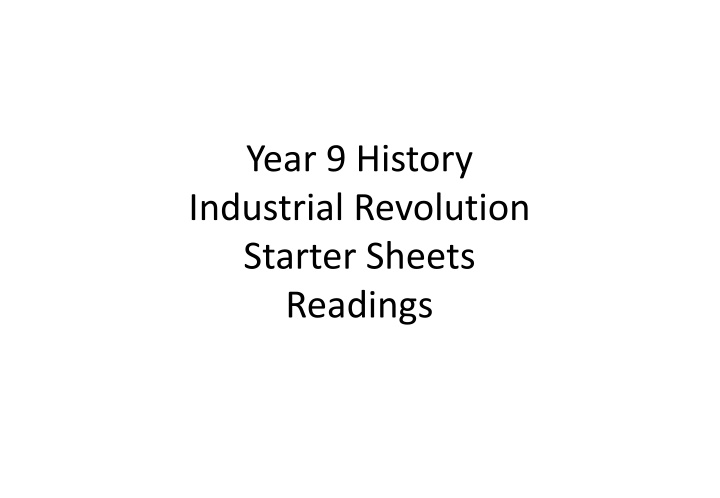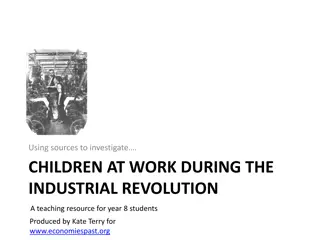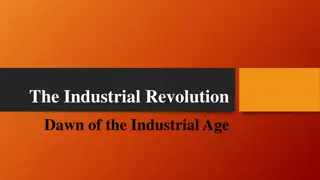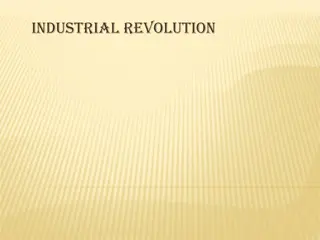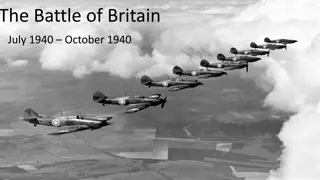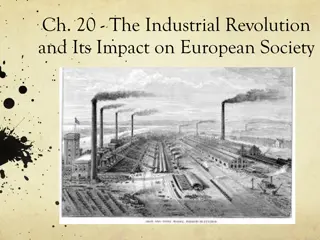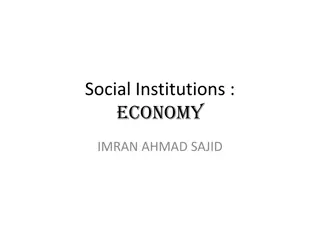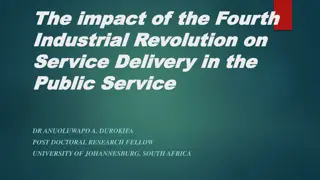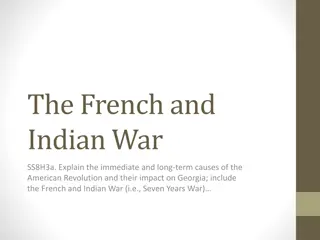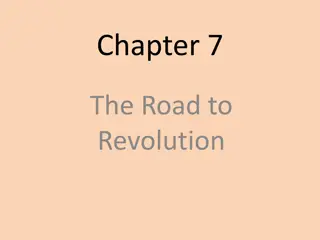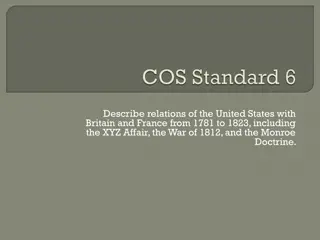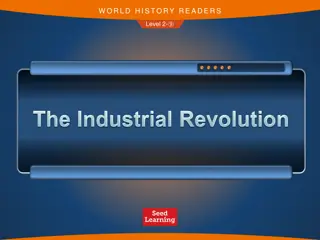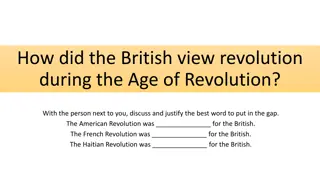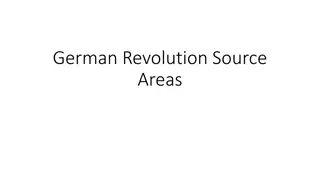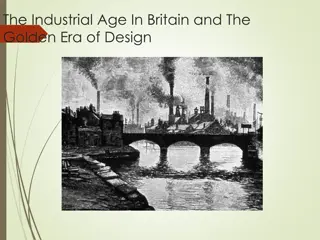Life in Britain During the Industrial Revolution
During the Industrial Revolution in Britain, there was a rise in the production of high-quality goods for export but limited job opportunities, slow transportation methods, and poor healthcare. The population growth due to the Agricultural Revolution impacted society, with Parliament making crucial decisions and Britain becoming a major world power with a growing empire.
Uploaded on Sep 17, 2024 | 0 Views
Download Presentation

Please find below an Image/Link to download the presentation.
The content on the website is provided AS IS for your information and personal use only. It may not be sold, licensed, or shared on other websites without obtaining consent from the author.If you encounter any issues during the download, it is possible that the publisher has removed the file from their server.
You are allowed to download the files provided on this website for personal or commercial use, subject to the condition that they are used lawfully. All files are the property of their respective owners.
The content on the website is provided AS IS for your information and personal use only. It may not be sold, licensed, or shared on other websites without obtaining consent from the author.
E N D
Presentation Transcript
Year 9 History Industrial Revolution Starter Sheets Readings
produced high quality goods that were sold abroad. But even these businesses employed no more than 50 people. common way of travelling but these could only be afforded by the rich, and roads were rare and bad. People who sweeps, flower sellers, doctors, housemaids, builders, cobblers and street traders all made a living in these fast were smallpox and respiratory diseases, pneumonia, bronchitis, diphtheria and tuberculosis. The average age of Parliament made the laws and were pretty much left to do most of the work but the King still had to agree with Everything a village or town needed was made by hand or on very simple machines buttons, needles, woollen or b. ___________________________________________________________________ sheep. They grew enough food to feed themselves and perhaps some extra to sell in the local town. Goods were a. ___________________________________________________________________ 1. Write down the heading. ________________________________________________ were less well off travelled on carts pulled by horses but the poor would have to walk everywhere they wanted _____________________________________________________________________ HealthPeople didn t know that germs caused disease. Basic operations, like removing an infected toenail, could _____________________________________________________________________ _____________________________________________________________________ _____________________________________________________________________ population grew so fast that one historian called it an explosion of people . This was because of improvements in agriculture called the Agricultural revolution. The population of Britain rose from 7 million people in 1750 to their decisions before they became law. Parliament held elections every few years but in 1750 only 5% of men imported Indian silk, jewels, pottery, ivory, tea, American coffee, sugar, tobacco and Canadian cod. Companies result in death because there were no painkillers or germ-free, clean, operating rooms. The big killer diseases made in people s homes or in small workshops attached to their homes. Some of the larger workshops in towns Empire By 1750 Britain was becoming a major world power. The British controlled areas of land in many other countries; parts of Canada, the West Indies, Africa, India and America were all under British control. Britain TransportPeople got around slowly very slowly. There were no aeroplanes, trains or cars. Most people rarely Population About 7 million people lived in Britain in 1750, but it is hard to know the exact number because no pottery and iron, were sold abroad in huge numbers. All this trade made a lot of money for British companies cloth cloths, glass, bricks, pottery, candles and bread. Some towns were growing fast. Shopkeepers, chimney sold these around Britain or they were exported to customers abroad. The goods made in Britain, like cloth, one ever counted. Historians have had to estimate by analysing church records. Between 1750 and 1900 the ___________________________________________________________________ c. ________________________________________________________________ Work About 8 out of 10 people lived and worked in the countryside. They grew food and reared cattle and death in Britain in 1750 was about 30 years of age. For every 1000 babies born, over 150 would die before could vote (these were the richest men) and women could not vote at all. Ireland had been conquered and left their village except to go to the local town on market day. Carriages pulled by horses were the most Year 9 Hist- Industrial Revolution Lesson 1 Reading Activity Britain before the 3. Circle the metalanguage words : empire, explosion of people, exported, parliament, Government In 1750, Britain was made up of England, Scotland and Wales and was ruled by George II. 12. Was life hard for the poor at the beginning of the Industrial Revolution? Why? 1750 ________________________ & 1900 ___________________________ 4. Write down the words you don t know the meaning of or find difficult to spell. ____________________________________________________________ 37 million in 1900. In just 150 years the population of Britain had more than quadrupled!! 9. Write down 3 things you have learnt from reading this passage. reaching their first birthday and 1 in 5 mothers would die too! 11. What countries made up Britain in 1801 10. What was the population of Britain in: and provided plenty of jobs for British workers. smallpox, vote, walk, workshop, 2. Number the paragraphs. became part of the UK in 1801. 7. Highlight 5 adjectives 8. Highlight 3 adverbs 6. Highlight 5 verbs. 5. Highlight 5 nouns. growing towns. Revolution to go.
____________________________________________________________________________________________________________________________________________ ______________________________________________________________________ ______________________________________________________________________ ______________________________________________________________________ ______________________________________________________________________ ______________________________________________________________________ ______________________________________________________________________ home Britain had large deposits of coal and iron ore which industrialisation depended on. It also had rich farming The agricultural revolution in which farming techniques improved drastically providing a surplus of food but also a. ___________________________________________________________________ b. ___________________________________________________________________ c. ___________________________________________________________________ 1. Write down the heading. ________________________________________________ 10. What did colonies provide? ______________________________________________ _____________________________________________________________________ The rise in Demand for cotton. Cotton clothes were cheaper, nicer to wear and easier to clean. Clothes were what A large population. The agricultural revolution and imports of meat from the colonies meant more food for the gaining colonies and good positions for trade which supplied valuable raw materials like cotton and markets for finance and insurance, with the result that London became the largest city in the world. By the turn of the century, 3. Circle the metalanguage words : agricultural revolution, coal, cotton, cotton gin, empire, lifespan also increased. Importantly, lower prices of food meant that people did not have to spend everything they the application of the steam engine to the textile industry that really drove the revolution and changed the face of with cotton from the industrial centres of northern England. It also dominated in related services such as shipping, people bought after food. Increased demand led development of machines such as the cotton gin. However it was steam engines and Britain had plenty. It meant machines replaced people in producing goods. People moved from transport of both coal and finished products. Canals, railways and roads all received significant investment. Steam- Britain the Empire. Britain had settled in North America and had defeated France in the war against Napoleon their products. By 1850, Britain dominated world trade in manufactured goods, supplying two-thirds of the globe people. Advances in medical knowledge and sanitation meant that fewer people died in infancy, and the average The invention of steam was used in many industries including mining and transport. Coal was used to power the ___________________________________________________________________ Good geographical position. Britain was in a good position for trade being on the western side of Europe. At 12. What do you think was the most important cause of the Industrial Revolution? Why? powered vessels that did not rely on wind for their propulsion gradually replaced less reliable sailing ships, and farming techniques, industrialisation, locomotives, population, purchase, rural, steam, Improved transport. Business owners in order to maximize their returns, invested their money improving the 4. Write down the words you don t know the meaning of or find difficult to spell. _______________________________________________________ Great Britain under Queen Victoria ruled about 20% percent of the world's land-mass. 11. Why were there more people in towns to work in the factories? 9. Write down 3 things you have learnt from reading this passage. Year 9 Hist - Industrial Revolution Lesson 2 Reading Activity a surplus of labour as small farmers were forced from their lands. earned on eating and could therefore purchase other products. steam-powered locomotives revolutionised transport on land. Why the Industrial Revolution happened in Britain lands to supply food for a growing population. rural environments to urban environments. surplus, transport, urban 2. Number the paragraphs. 7. Highlight 5 adjectives 8. Highlight 3 adverbs 6. Highlight 5 verbs. 5. Highlight 5 nouns. society.
became/become. Individuals and groups formed/forms new libraries, schools, and universities housing had unsanitary features which led to diseases workers who were desperate lived near in the working class many were replaced in factories by machines but on the other hand many to obtain employment resources started diminishing and the use of pesticides and hazardous The middle and upper classes had/have better food and housing, which led/lead a. ___________________________________________________________________ b. ___________________________________________________________________ 1. Write down the heading. ________________________________________________ the amount of carbon dioxide increased two-fold as people moved closer to factories hoping Two classes that benefited from it was/werethe "middle" and upper classes. the average adult worker worked quite often five to seven days of the week for more than The middle class was/were composed of businessmen and other professionals. treated so well, their/there/they re population grew and thus had/have minimal difficulty The Industrial Revolution made drastic changes on the lives of individuals. c. _________________________________________________________________: privileges such as few people voted nor were they allowed to do anything to improve their worked for relatively low wages due to their incapability to produce goods the women and though most could afford goods anyway, the prices lowered even more, so that those who half the day per shift children as young as fifteen worked for minimal wages some of the ___________________________________________________________________ These two classes was/were composed of people that had/have wealth and success. Even Year 9 Hist - Industrial Revolution Lesson 3 Reading Activity Experiences of the because their/there/they rewas/were a sudden need for education (possibly due to the what also made life difficult during the industrial revolution was that there were limited the housing was not desirable either for example there was frequent overcrowding. the children became deformed or crippled due to their work which was often most workers could not afford them before could now enjoy the comfort and convenience of the new to fewer diseases and longer living among these groups. Since these classes was/were The larger the Industrial Revolution grew/grow, the more powerful these individuals 3. Circle the metalanguage words : classes, education, factories, housing, middle, 4. Write down the words you don t know the meaning of or find difficult to spell. in contrast with the middle and upper classes the "working" class was not well off 9. Write down 3 things you have learnt from reading this passage. Punctuation exercise: put in commas, full stops and capitals. also gained new jobs in factories working with machinery children were not paid as much as the men were living during the Industrial Revolution. professionals, upper, working class working condition that was legal Cross out the wrong word. chemicals began to increase 2. Number the paragraphs. products being/been made. 7. Highlight 5 adjectives increase in population). 8. Highlight 3 adverbs 6. Highlight 5 verbs. 5. Highlight 5 nouns. a factory people
which water constantly stagnates, and are so covered with refuse and excrement as to be impassable water could have been contaminated with sewage from a leaking cesspit. Those who lived near a river could water supplies, the best people could hope for was to leave a bucket out and collect rainwater. Some areas There was a huge growth in the size of British cities. In 1695, the population of Britain was ____________________________________________________________________________ ____________________________________________________________________________ ____________________________________________________________________________ 10. What percentage growth in population was there between 1695 and 1841? __________________ These cities needed cheap homes. There were few building regulations then and those that often had no windows, heat or inside bathrooms, and as many as 10 people slept in one small room. None of a. ___________________________________________________________________ b. ___________________________________________________________________ c. ___________________________________________________________________ estimated to be 5.5 million. By 1801, it was 9.3 million and by 1841, 15.9 million. As enclosure and technical 1. Write down the heading. ________________________________________________ developments in farming had reduced the need for people to work on farmland, many people moved to the home with the water being collected from a local pump or you simply did not wash. Many didn t wash as it did exist were frequently ignored. Therefore, a house was put up quickly and cheaply and as many were cities to get accommodation and a job. These cities were not prepared for such an influx in such a short use river water. However, this is where night-men emptied their carts full of sewage and where general cesspits. When these were filled they had to be emptied and what was collected was loaded onto a cart before their first birthday. Cities had no sewers and garbage was thrown into the street. Toilets were terrace housing. These had no garden and the only part of the building not connected to another house their work had to be done at night as the stench created by emptying the cesspits was too great to be would be the front (and only) entrance (unless you were lucky enough to live in the end of the terrace). families struggled to survive in crowded slums. The buildings they lived in were called tenements. They before being dumped in a local river. This work was also done by the night-men. Local laws stated that "Whole streets, unpaved and without drains or main sewers, are worn into deep ruts and holes in ___________________________________________________________________ building material used was the cheapest a builder could find. The finished homes were damp. The poor _________________________________________________________________________ these homes was built with a bathroom, toilet or running water. You either washed in a tin bath in the were lucky enough to have access to a well with a pump but there was always the chance that the well tolerated during the day. The streets where the poor lived were poorly kept. A doctor in Manchester Fresh water supplies were also very difficult to get in the poor areas. With no running centuries the great fear was a cholera, typhus or typhoid epidemic. More than half of all babies died 3. Circle the metalanguage words : accommodation, back to back housing, cities, estimated, Sanitation and hygiene barely existed and throughout the eighteenth and nineteenth built as was possible. The Industrial Revolution saw the start of what were known as back-to-back The poor people lived in the oldest part of the city, near the downtown district. The period of time and cities suffered problems not witnessed anywhere else in the world at this time. ______________________________________________________________________ Year 9 Hist - Industrial Revolution Lesson 4 Reading Activity Life in Industrial towns 4. Write down the words you don t know the meaning of or find difficult to spell. 12. What do you think poor people could have done to improve their lives? 9. Write down 3 things you have learnt from reading this passage. rubbish was dumped. Any water collected would have been diluted sewage. 11. What problems do you think would arise? List 5 hygiene, sanitation, sewerage, slums, stench from depth of mud and intolerable stench. 2. Number the paragraphs. 7. Highlight 5 adjectives 8. Highlight 3 adverbs Life in Industrial Towns 6. Highlight 5 verbs. 5. Highlight 5 nouns. wrote about the city: was simply easier.
For many skilled workers, the quality of life decreased a great deal in the first 60 years Families, including husbands and wives, were separated upon entering the grounds. They were confined efficient flow of work at the factories. After the 1850s, however, recreation improved along with the of the Industrial Revolution. Skilled weavers, for example, lived well in pre-industrial society as a kind 12. What years were the first 60 years of the Industrial Revolution? __________________ cricket became popular. Football became a professional sport in 1885. By the end of the 19th century, workers migrated from the country to the city, their lives and the lives of their families were utterly of middle class. They tended their own gardens, worked on textiles in their homes or small shops, and neighbourhoods, people did not share the same traditional sense of a village community. Owners fined with little energy, space, or light to play sports or games. The new industrial pace and factory system 10. Why did factory owners fine workers who went home for festivals? ________________ c. ___________________________________________________________________ 11. Why didn t the poor play sport? ___________________________________________ a. ___________________________________________________________________ b. ___________________________________________________________________ 1. Write down the heading. ________________________________________________ _____________________________________________________________________ government. The Poor Law of 1834 created workhouses for the destitute. Poorhouses were designed appearance they made with their families at markets, or at public worship. These houses were now a seemed happy and contented. . . . it was seldom that a weaver appealed to the parish for a relief. . . . conditions for skilled weavers significantly deteriorated. They could no longer live at their own pace pocket, and the women dressed in their own fancy, the Church crowded to excess every Sunday, and order; I remembered their whitewashed houses, and their little flower gardens, and the decent raised farm animals. They were their own bosses. One contemporary observer noted, their dwelling to be deliberately harsh places to discourage people from staying on relief (government food aid). rise of an emerging the middle class. Music halls sprouted up in big cities. Sports such as rugby and little time or opportunity for recreation. Workers spent all the light of day at work and came home quality of life took a sharp downturn: A quarter [neighbourhood] once remarkable for its neatness every house well furnished with a clock in elegant mahogany or fancy case. . . . Their little cottages During the first 60 years of the Industrial Revolution, living conditions were, by far, were at odds with the old traditional festivals which dotted the village holiday calendar. Plus, local Working in new industrial cities had an effect on people s lives outside of the factories as well. As worst for the poorest of the poor. In desperation, many turned to the poorhouses set up by the 3. Circle the metalanguage words : communal, cottages, decreased, pre-industrial, middle In the first sixty years or so of the Industrial Revolution, working-class people had ___________________________________________________________________ cities had become the places with opportunities for sport and entertainment that they are today. workers who left their jobs to return to their villages for festivals because they interrupted the or supplement their income with gardening, spinning, or communal harvesting. For skilled workers, workhouse inmates increased from 78,536 in 1838 to 197,179 in 1843 . This increase can only be Year 9 Hist - Industrial Revolution Lesson 5 Reading Activity Life in Industrial and small gardens clean and neat, all the family well clad, the men with each a watch in their each day as inmates in a prison and worked every day. Yet, despite these very harsh conditions, governments actively sought to ban traditional festivals in the cities. In the new working-class peace and content sat upon the weaver s brow . But, after the Industrial Revolution, the living 4. Write down the words you don t know the meaning of or find difficult to spell. 8. Write down 3 things you have learnt from reading this passage. viewed as a sign of desperation amongst the poorest of the poor. 5. Highlight 5 nouns. Highlight 5 verbs. class, transformed, workhouses and permanently transformed. 2. Number the paragraphs. 6. Highlight 5 adjectives mass of filth and misery . 7. Highlight 3 adverbs towns
night air led to many cases of pneumonia. The air was full of dust, which led to chest and lung diseases so tired they were falling asleep on their feet - led to many accidents. It was said that 40 per cent of 11. What punishments were given? __________________________________________________ ____________________________________________________________________________ ____________________________________________________________________________ ____________________________________________________________________________ children s necks, hanging them from the roof in baskets, nailing a child s ear to the table, and dowsing 3. Circle the metalanguage words : apprentices, deformities, diseases, fines, machines, minimum, time on the clocks to make their workers late so that they could fine them. Some employers required during brisk times when trade was good. Workers were often required to clean their machines during a. ___________________________________________________________________ b. ___________________________________________________________________ c. ___________________________________________________________________ barracks attached to the factory, in the beds just vacated by children about to start the next shift. _________________________________________________________________________ 1.Long working hours normal shifts were recorded as 12 to 14 hours a day, with extra time required their mealtimes. It was claimed that employers changed the clocks to get a few minutes extra out of 1. Write down the heading. ________________________________________________ 10. How many hours did people work a day? ___________________________________________ 6.Accidents forcing children to crawl into dangerous, unguarded machinery - often when they were 5.Deformities many children who were forced to stand for long hours grew up with conditions such 7.Health cotton thread had to be spun in damp conditions at 70 F. Going straight out into the cold 4.Fierce systems of fines fines were imposed for things like talking or whistling, leaving the room This is the kind of information you would get if you read an older textbook such as "History Alive" 3.Cruel discipline frequent strapping (it was claimed that children had been thrashed to death). without permission, of having a little dirt on a machine. It was claimed that employers altered the (15p). For this reason, employers preferred to employ women and children. Many men were sacked ___________________________________________________________________ children were paid much lower wages, with women earning 7 shillings (35p) and children 3 shillings 2.Low wages a typical wage for male workers was about 15 shillings (75p) a week, but women and Women and children were easily bullied. One witness claimed that he had seen an iron bar driven factory owners, supposedly to learn the textiles trade. They worked 12-hour shifts, and slept in Year 9 Hist - Industrial Revolution Lesson 6 Reading Activity Children of the Revolution through the cheek of one girl. Other alleged punishments included hanging iron weights around 8.Parish apprentices orphans from workhouses in the south of England were "apprenticed" to 4. Write down the words you don t know the meaning of or find difficult to spell. when they reached adulthood and had to be supported by their wives and children. 12. Why are you glad you are not a factory worker in the Industrial Revolution? accident cases at Manchester Infirmary in 1833 were factory accidents. 9. Write down 3 things you have learnt from reading this passage. their overseers to raise a minimum amount each week from fines. and loud noise made by machines damaged workers' hearing. (1968) or "Machine, Money and Men" (1969): them in water butts to keep them awake. shifts, shillings, strapping, wages, Nine factory working abuses 2. Number the paragraphs. as knock-knees and bow legs. 7. Highlight 5 adjectives their workers every day. 8. Highlight 3 adverbs 6. Highlight 5 verbs. 5. Highlight 5 nouns.
people in Great Britain were eligible to vote, workers could not use the democratic political system to fight For the first generation of workers from the 1790s to the 1840s working conditions were very tough, and sometimes tragic. Most laborers worked 10 to 14 hours a day, six days a week, with no paid ______________________________________________________________________ ______________________________________________________________________ ______________________________________________________________________ ______________________________________________________________________ vacation or holidays. Each industry had safety hazards too. Under such dangerous conditions, accidents on c. ___________________________________________________________________ a. ___________________________________________________________________ b. ___________________________________________________________________ the village during harvest time to help their families, unless they wanted to lose their jobs. Instead, they Life in the factory was most challenging for the first generation of industrial workers who 1. Write down the heading. ________________________________________________ whose talents and experience became useless because they could not compete with the efficiency of the complete change of pace and discipline from the village life. Workers could not wander over to chat with factories to get work. This resulted in a very high unemployment rate for workers in the first phases of their neighbors or family as they would have done while working in the country. They could not return to more unskilled labourers, who had few skills and would take any job, than there were jobs for them. And were no longer their own bosses; foremen and overseers supervised a new working culture to insure that regulate them. Desperate for work, the migrants to the new industrial towns had no bargaining power to business for themselves or winning a job as a supervisor, But the majority saw very little social mobility. workers actions were focused and efficient. A few workers were able to improve their lot by going into 3. Circle the metalanguage words: landowners, migrants, reforms, textiles, unemployment, As a result, the new factory owners could set the terms of work because there were far their new employers. Since population was increasing in Great Britain at the same time that landowners the job occurred regularly. Injured workers would typically lose their jobs and also receive no financial since the textile industries were so new at the end of the 18th century, there were initially no laws to for rights and reforms. In 1799 and 1800, the British Parliament passed the Combination Acts, which ___________________________________________________________________ ___________________________________________________________________ The working class who made up 80% of society had little or no bargaining power with Many of the unemployed or underemployed were skilled workers, such as hand weavers, demand higher wages, fairer work hours, or better working conditions. Worse still, since only wealthy 12. What role, if any, do you think the government should have taken to improve working were enclosing common village lands, people from the countryside flocked to the towns and the new made it illegal for workers to unionize, or combine, as a group to ask for better working conditions. still remembered the slower and more flexible pace of country life. Factory employers demanded a 4. Write down the words you don t know the meaning of or find difficult to spell. Year 9 Hist - Industrial Revolution Lesson 7 Reading Activity 9. Write down 3 things you have learnt from reading this passage. conditions in the new industrial factories, mills, and coal mines? 11. Why were the lives of textile workers especially hard? compensation for their injury to pay for much needed health care. _______________________________________ 10. What percentage were working class? unskilled, working conditions 2. Number the paragraphs. Children of the Revolution 7. Highlight 5 adjectives 8. Highlight 3 adverbs the Industrial Revolution. 6. Highlight 5 verbs. 5. Highlight 5 nouns. new textile machines.
______________________________________________________________________ the 19th century. The city of London grew from a population of two million in 1840 to five million forty had a population of 22,000 . Over the next fifty years, Manchester s population exploded and reached people in a country Great Britain lived in cities than in rural areas. As other countries in Europe and ______________________________________________________________________ ______________________________________________________________________ Despite the growth in wealth and industry urbanization also had some negative effects. One of the defining and most lasting features of the Industrial Revolution was the rise North America industrialized, they too continued along this path of urbanization. By 1920, a majority ___________________________________________________________________ a. ___________________________________________________________________ b. ___________________________________________________________________ c. ___________________________________________________________________ ___________________________________________________________________ ___________________________________________________________________ 11. How many people lived in rural areas before the Industrial Revolution? ____________________ 1. Write down the heading. ________________________________________________ 3. Circle the metalanguage words : environmental, industrialised, polluted, rural, textile industry, workers and factories together. And the new industrial cities became, as we read earlier, sources of of Americans lived in cities. In England, this process of urbanization continued unabated throughout of cities. In pre-industrial society, over 80% of people lived in rural areas. As migrants moved from textile capital of the world, drawing huge numbers of migrants to the city. In 1771, the sleepy town The small town of Manchester, England also grew rapidly and famously to become the This process of urbanization stimulated the booming new industries by concentrating the countryside, small towns became large cities. By 1850, for the first time in world history, more Nowadays most of the populations of industrialised nations live in cities but with the arrival of the complete development and its most brutish, here civilization works its miracles and civilized man is their land by their English landlords. In Liverpool and Manchester roughly 25 to 33 percent of the 180,000. Many of the migrants were destitute farmers from Ireland who were being evicted from ___________________________________________________________________ quintessential industrial city. Its cool climate was ideal for textile production. And it was located close to the Atlantic port of Liverpool and the coalfields of Lancashire. The first railroads in the environmental hazards. From this foul Drain the greatest stream of human industry flows out to fertilize the whole world. From this filthy sewer pure gold flows. Here humanity attains its most 10. Underline the following words: environmental, industrialised, polluted, rural, textile industry, Year 9 Hist - Industrial Revolution Lesson 8 Reading Activity Effects of the Revolution world later connected the textile town to Liverpool. As a result, Manchester quickly became the On the whole, working-class neighbourhoods were bleak, crowded, dirty, and polluted. Alexis de Tocqueville, a French traveller and writer, visited Manchester in 1835 and commented on the 4. Write down the words you don t know the meaning of or find difficult to spell. 13.What does the writer mean by From this filthy sewer pure gold flows. 9. Write down 3 things you have learnt from reading this passage. 12. Why did Manchester become the quintessential industrial city? technological revolution will this change? 2. Number the paragraphs. turned almost into a savage. 7. Highlight 5 adjectives 8. Highlight 3 adverbs 6. Highlight 5 verbs. 5. Highlight 5 nouns. wealth for the nation. workers were Irish.. urbanisation urbanisation Urbanization years later.
needed for the household. Work and play time were flexible and interwoven. Industrialisation changed there till she was married, two years ago. She is nineteen next June. John was not eight when he went Mr Samuel Wilson (now dead) came to Derby to get my hand, and I engaged with him with my family. I struggling to survive. Her life shows the unfortunately common death rate of infants. Jane Goode had 3. Circle the metalanguage words : agricultural, economic, household, monotonous, repetitive, shillings 9 pence. She pays it all to me. She has worked there nine years. She has been at the drawing- ___________________________________________________________________ The Industrial Revolution completely transformed the role of the family. In traditional, I have had five children that have all worked at the factory. I have only one that works head all the while. She got 2 shilling when she first went. She was just turned seven. . . . Mary did not work here [at the factory] long. She went in about fourteen or fifteen. She was married last summer. income for the family. In difficult circumstances, mothers struggled to make ends meet and keep the purpose of raising money to support each other. As we have seen, children often worked to earn some decline. While many factory workers were initially women, most of them were young women who would those who worked at the mill. There were five that died before they were a quarter of a year old. . . . ___________________________________________________________________ all that. The same specialisation of labour that occurred in factories occurred in the lives of working- in; he is now twenty-two. . . . I have had twelve children altogether. I thought you were asking only of a. ___________________________________________________________________ b. ___________________________________________________________________ c. ___________________________________________________________________ ___________________________________________________________________ ___________________________________________________________________ 1. Write down the heading. ________________________________________________ She is thirty next June. She went on working at Elliot and Mill s and other factories till she married. class families, and this broke up the family economy. Work and home life became sharply separated. sweaters, or tending to the fire. Women could parent and also play a role in producing food or goods performed in pre-industrial society, factory workers typically completed repetitive and monotonous Industrial working-class families, though not working together, did serve an economic Factory Commission in 1833. The history of her family shows the worries and stresses of a mother Anne was just turned seven; she worked here four years, then she went to Mr Elliot s, and worked 12.In what ways are work in a factory similar today as in the Industrial revolution times? ___________________________________________________________________ Men earned money for their families. Women took care of the home and saw their economic role there now. She is sixteen. She works in the card-room. She minds the drawing-head. She gets 5 agricultural society, families worked together as a unit of production, tending to fields, knitting family out of the poorhouses. Jane Goode, a working-class mother, testified before the British quit working when they married. In stark contrast to the various changing tasks that a farmer Year 9 Hist - Industrial Revolution Lesson 9 Reading Activity Effects of the 4. Write down the words you don t know the meaning of or find difficult to spell. 10.What became sharply separated after the Industrial Revolution? 9. Write down 3 things you have learnt from reading this passage. 11. How did the nature of work change from a farm to a factory? twelve children, but five died before the age of two: did it to keep my children off the parish [welfare]. Working Class Families and The Role of Women specialisation , transformed, tasks for 10 to 14 hours each day. 2. Number the paragraphs. 7. Highlight 5 adjectives 8. Highlight 3 adverbs 6. Highlight 5 verbs. 5. Highlight 5 nouns. Revolution
required more of what we call today white collar jobs, such as business people, shopkeepers, in England that increased from 300 in 1875 to 2,600 by 1890. Another mark of distinction of two major classes in society: aristocrats born into their lives of wealth and privilege, and low- ___________________________________________________________________ One piece of evidence of this emerging middle class was the rise of retail shops 900,000 to 1.4 million. This is proof of a small but rising middle class that prided themselves Year 9 Hist - Industrial Revolution Lesson Reading Activity Effects of the Revolution a. ___________________________________________________________________ b. ___________________________________________________________________ c. ___________________________________________________________________ ___________________________________________________________________ ___________________________________________________________________ ___________________________________________________________________ 1. Write down the heading. ________________________________________________ industrial cities, mostly toward the end of the 19th century. Until then, there had been only 3. Circle the metalanguage words : aristocrats, domestic servants, middle class, merchants, 11. What jobs did they do?_________________________________________________ on taking responsibility for themselves and their families. They viewed professional success In this new middle class, families became a sanctuary from stressful industrial teachers. [Middle-class people tended to have monthly or yearly salaries rather than hourly time. Not surprisingly, from 1851 to 1871, the number of domestic servants increased from the middle class was their ability to hire servants to cook and clean the house from time to life. Home remained separate from work and took on the role of emotional support, where working outside the home. They could afford to send their children to school. As children ___________________________________________________________________ became more of an economic burden, and better health care decreased infant mortality, women of the house created a moral and spiritual safe harbor away from the rough-and- bank clerks, insurance agents, merchants, accountants, managers, doctors, lawyers, and income commoners born in the working classes. However new urban industries gradually tumble industrial world outside. Most middle-class adult women were discouraged from Gradually, very gradually, a middle class, or middling sort , did emerge in 4. Write down the words you don t know the meaning of or find difficult to spell. 9. Write down 3 things you have learnt from reading this passage. as the result of a person s energy, perseverance, and hard work. 12.How could you tell if someone was middle class? middle-class women gave birth to fewer children 10.What is a middle class person? retail, society, white collar, The Emerging Middle Class 2. Number the paragraphs. 7. Highlight 5 adjectives 8. Highlight 3 adverbs 6. Highlight 5 verbs. 5. Highlight 5 nouns. wages.]
